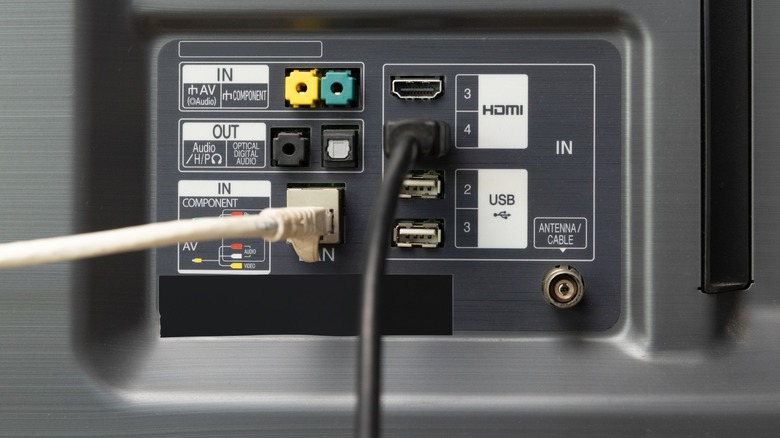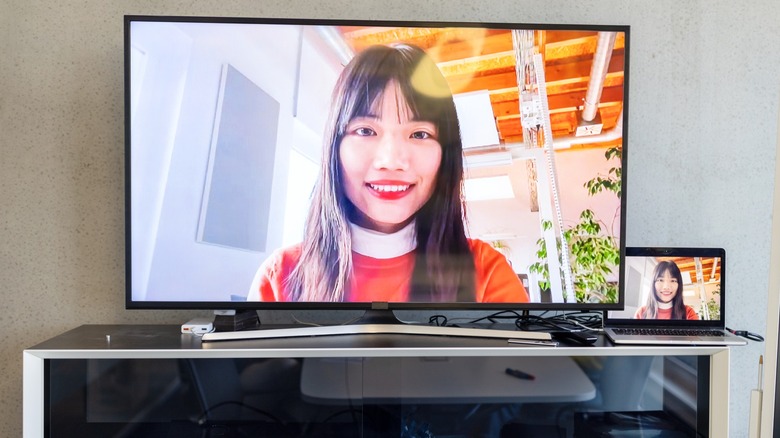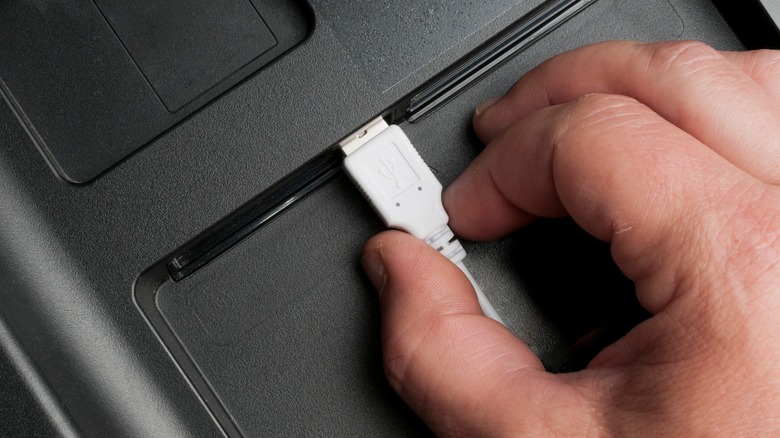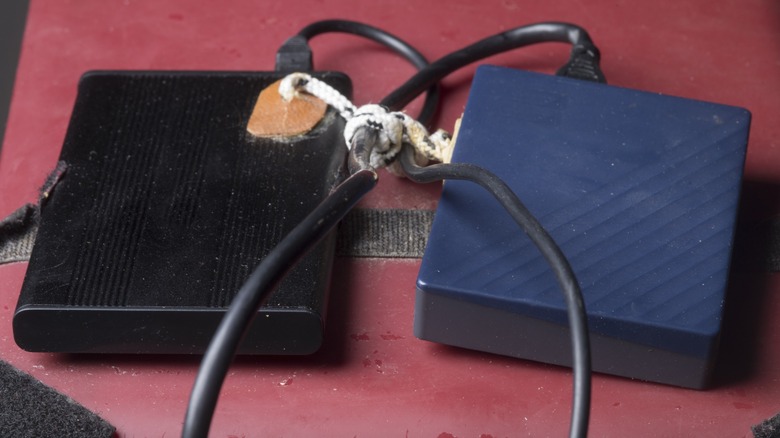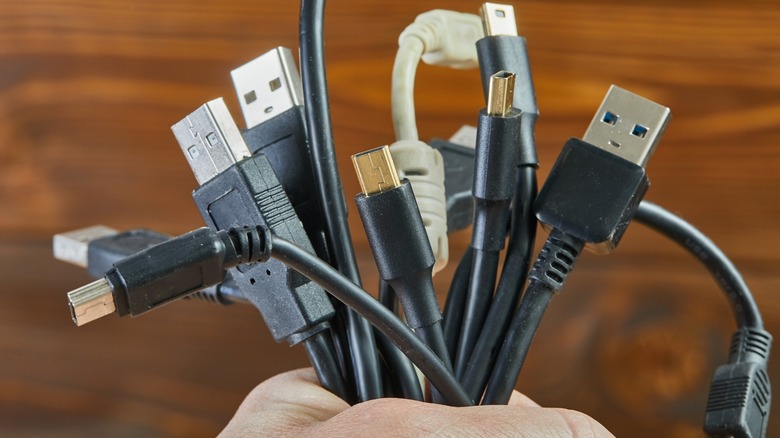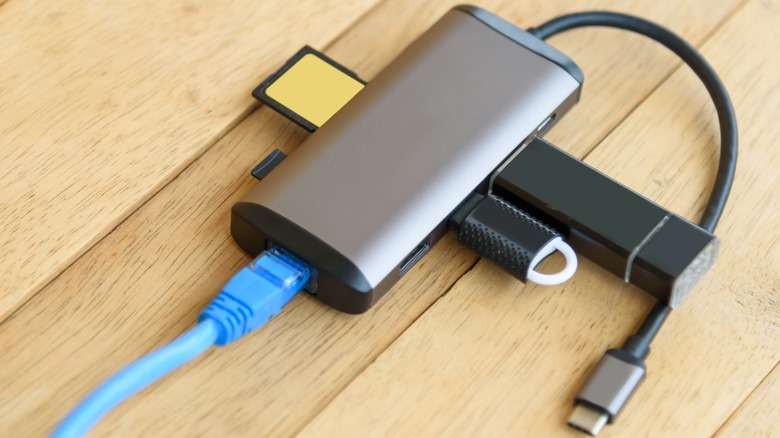5 Things You Should Never Plug Into Your TV's USB Ports (And Why)
Most people set up a smart TV once and never touch it again. And all things considered, they never really need to. Once you turn on the TV, the remote or even your phone helps you navigate the rest. That, however, leaves a bunch of small, square-ish ports on the back panel doing nothing, which is a shame considering the fact that a TV's USB port can read files. Technically, with the help of accessories, you can also make video calls. In fact, some models can even help record live TV shows.
If you want to explore what options your TV supports, start with our guide on how to use the USB ports on your TV. And if you need ideas, there's a long list of cool gadgets you can plug into your TV's USB port. That said, a TV's USB port isn't a wall outlet. You may be tempted to treat it like you would a laptop's port and try to charge a phone or run a small fan when you're in a pinch, but the wrong device can damage the port itself by drawing too much power from the TV, corrupting internal circuits, and even triggering a complete meltdown. Before you reach into the drawer and start testing random dongles, it helps to know what to keep away from that port entirely.
Laptops, tablets, and smartphones
A TV looks huge next to a phone or a laptop, so if your laptop can charge your phone, you might assume the TV's USB port has even more power to spare. It doesn't. When it comes to power delivery, it's not really about size. It's more of a design thing. For context, a compact GaN charger smaller than a deck of cards can deliver 65 watts or more. However, a typical USB 2.0 port gives about 2.5 watts, and even USB 3.0 only reaches roughly 4.5 watts.
And that's because each device was designed to do something specific. The TV is only a display unit. It's built to show video you feed it over HDMI or over a wireless protocol. Similarly, the USB port is there to read a flash drive or power small accessories like streaming dongles. You may even use the TV as a monitor by plugging in an HDMI cable from your laptop or using a USB-C to HDMI adapter.
Of course, if you plug a laptop or tablet into the TV's USB, you might activate the charging icon, but that's a trickle at best. Laptops need 45 to 100 watts to really charge. Most tablets draw between 15 and 45 watts. Modern smartphones typically require 18 to 20 watts for fast charging, with some flagship models needing even more. That's way more power than the TV's 2.5 to 4.5-watt limit can share. In fact, some TVs shut the USB off when they detect too much draw. which is why you might notice your device keeps getting disconnected.
Devices that generate heat
It's a bad idea to plug any device that generates heat into your TV's USB port. Why? For starters, look at the placement. Many TVs place their USB ports on the back panel, tucked into tight recesses with little to no airflow. If you stick a heat-producing device into that confined space, you're basically creating a pocket of hot air that just sits and recirculates. And TV manufacturers are clear about not blocking ventilation or placing the set near heat sources. Too much heat over time can damage the circuitry inside your TV.
The obvious no-nos are USB warming pads, mug warmers, and portable fan heaters — basically anything designed to get hot. But here's where it gets tricky: even retro gaming consoles can be a problem. Take the PlayStation Classic as an example. It's rated around 5 watts, which doesn't sound like much, but that's already more than most TV USB ports are built to handle. That draw can spike even higher during installation. It gets worse with third-party emulation boxes and mini PCs, which can draw between 20 and 25 watts or even higher.
When you try to power these through your TV's limited USB port, the console's processor ends up working harder to make up for the power deficit, which means even more heat inside an already cramped space. Gaming controllers, on the other hand, don't have the same problem. The issue is mainly with consoles and emulation devices, since they're running full processors, not just small batteries.
Large external drives
At this point, you're probably wondering if there's anything you can actually pair with your TV's USB ports. Well, these ports do well with the basics. You can plug in small flash drives formatted in FAT32 or NTFS with standard media files such as MP4, MKV, MP3, and JPG. On some TVs, if the file you intend to open is larger than 4 GB, then the drive should be formatted in exFAT. So, you see, the size and the format matter a lot.
Most manuals also give a limit of 32 GB for thumb drives and 2 TB for USB hard drives. When it comes to large external hard drives with spinning disks, you're bound to have some issues. These need far more power than most TVs can provide to spin. And if a drive doesn't get enough power, it won't run in the first place. Even if it does, there's a high chance it will disconnect mid-transfer and damage your files.
Similarly, if you've ever tried to hook up an old external optical drive or other peripherals through USB, you may have noticed they don't work at all. That's because, even though the USB connector fits, your TV's software can't actually decode the drive. In short, TVs just don't have the right drivers for most peripherals. And so the biggest takeaway here is that just because a gadget has a USB connector doesn't mean it will work with every USB port. Manufacturers know this, and that's why they still ship wall adapters with a lot of peripherals.
Bootleg dongles
No doubt, there are high-tech gadgets worth every bit of the hefty price tag, and that really means something different for everybody. However, with accessories, it's easy to think: what even is the difference between what you're getting from a reputable brand compared to a more obscure one?
Well, quite a few things actually. For one, many of the USB-to-HDMI adapters and converters from no-name brands are just not well-made. A lot of them often lack proper power regulation, so they may pull more current from the TV than they're supposed to. You're also more likely to experience transmission issues where the screen just keeps flickering or the audio keeps cutting in and out.
Having that occur repeatedly stresses both the port and the TV in general. But with the more reputable brands, you're paying a little more for quality design, stable signals, and less risk to the TV.
Random drives and hubs
Borrowing a thumb drive or using a random converter you found in a drawer might seem like a harmless thing to do. But you can't be too sure where it's been. Smart TVs can index and parse files, and so a damaged drive can be the reason your TV suddenly starts lagging, gets exposed to malware, or even crashes.
So, be wary of using random dongles, flash drives, or USB hubs. Speaking of USB hubs, many TVs don't support them at all. For the ones that do, a powered hub is a more reliable option. For context, there are two types of USB hubs: powered and unpowered. The powered hubs are generally more expensive, but the major difference is that they're not dependent on your TV for power. You have to connect them to a major power source, like a wall outlet, for them to work.
Overall, it helps to remember that the port is there only for light-duty tasks. So, connecting a small, trusted thumb drive is fine, and using the port for an HDMI connection for video is fine as well. Just don't turn the TV's USB port into a substitute power source.
